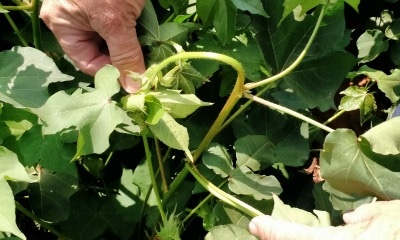
It's wet; it's warm and the forecast says it is going to stay that way.
Southern Kansas Cotton Growers Association crop consultant Rex Friesen says that means a tough call for cotton growers -- when do you stop applications of growth regulator?
For growers who got their cotton planted ahead of the spring monsoons, the crop close to maturity and growers may even be applying boll opener in a couple of weeks. For those who had to wait to plant until the rains paused and pushed right up against the deadline for planting, the decision is harder because in many fields, that crop is still growing.
Friesen said there are several factors to evaluate:
1) Where is the 1st position white bloom on the stalk?

RUBBERY JOINT: If the bend is only a inch of two down the stalk, the plant is mature and no growth regulator is needed. But if the bend is much further down, the top will grow some more and one more application might be a good idea.
"I often talk about Nodes Above White Flower, which is essentially an indication of plant vigor in regards to putting on or retaining new fruit."
At this time on the calendar, lower is definitely better than higher he said because it indicates the plant has made a significant shift in energy allocation from fruit production to boll maturation. That shift also shows up in less growth in the upper stalk or the length between main stem nodes up top.
2) What is the length between the top several main stem noes or "internode" length?
"Look at the stem lengths between each of the top five nodes," Friesen said. "If the length between nodes 3-4 and 4-5 are 2 to 3 inches, that is a yellow flag.
3) How "rubbery" is the top of the plant stem? Where is the "red"?
"These two factors are usually closely related," Friesen said. "Take the top leaf and pull it nearly straight down to see where it flexes. This usually corresponds with the rising "red" on the stalk, which is an indication that the stalk is 'barking up'."
That area has little stretch left in it, but the light green, rubbery portion does. If the bend is only a inch of two down the stalk, the plant is mature and no growth regulator is needed. But if the bend is much further down, the top will grow some more and one more application might be a good idea.
4) How are growing conditions?
This year there is abundant water, abundant nitrogen and mild temperatures. Those conditions are perfect for growth.
5) Is the fruit load heavy or light?
A lot of medium to large bolls on a plant are a good, natural braking system for plant growth, Friesen said. On the other hand, a lot of squares and small bolls won't hold growth back much.
6) Current plant height
"Is the plant waist high or above?" Friesen asks. "I like to work at keeping them waist high or less, but for some it's too late for that."
Friesen said he realizes that growers have already spent a lot of money on this crop. Deciding whether to spend a little more may come down to realizing that the final lint quality grade can be significantly affected by high leaf and trash.
"As an example, a leaf grade of 5 or 6, can result in loan rates of $0.5002 and $0.4825, respectively, compared with $0.5200 on standard grade cotton (leaf = 4). That’s a loss of a minimum of $19.80 and $37.50 per acre, respectively, on 1000 lb cotton, simply because it didn’t strip/clean up well. That's something to keep in mind, if you are still in a position to do something about it," Friesen said.
About the Author(s)
You May Also Like






